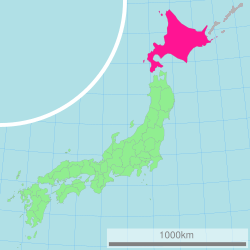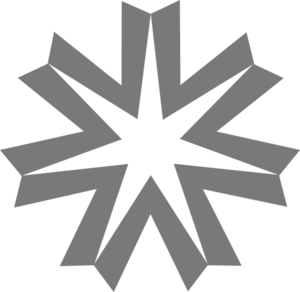Hokkaidō Prefecture facts for kids
Quick facts for kids Hokkaidō |
|||||||||
|
|||||||||
 |
|||||||||
| Capital | Sapporo | ||||||||
| Region | Hokkaido | ||||||||
| Island | Hokkaidō | ||||||||
| Governor | Harumi Takahashi | ||||||||
| Area (rank) | 83,453.57 km² (1st) | ||||||||
| - % water | 6.4% | ||||||||
| Population (2010-10-01) | |||||||||
| - Population | 5,507,456 (8th) | ||||||||
| - Density | 66.4 /km² | ||||||||
| Districts | 68 | ||||||||
| Municipalities | 180 | ||||||||
| ISO 3166-2 | JP-01 | ||||||||
| Website | |||||||||
| Prefectural Symbols | |||||||||
| - Flower | Hamanasu (Rugosa Rose, Rosa rugosa) |
||||||||
| - Tree | Ezomatsu (Jezo Spruce, Picea jezoensis) |
||||||||
| - Bird | Tanchō (Red-crowned Crane, Grus japonensis) |
||||||||
| - Fish | Sea Bream | ||||||||
 Symbol of Hokkaidō Prefecture |
|||||||||
Hokkaidō Prefecture is a special part of Japan. It's the northernmost prefecture, located on the large island of Hokkaidō.
Its capital city is Sapporo.
Contents
History of Hokkaidō
- Further information: Former Provinces of Hokkaidō
Long ago, before 1869, the island was known by different names like Ezo. But since 1869, it has been called Hokkaidō.
Many people moved to Hokkaidō in the late 1800s, causing its population to grow.
Important Dates in Hokkaidō's History
Here are some key moments in Hokkaidō's past:
- 1947 (Shōwa 22): Hokkaidō Prefecture was officially created.
- 2008 (Heisei 20): The 34th G8 summit, a big meeting of world leaders, took place in Toyako.
Geography of Hokkaidō
Hokkaidō is the second largest island in Japan. It is surrounded by different bodies of water. The Sea of Japan is to its west, the Sea of Okhotsk to its northeast, and the Pacific Ocean to its southeast. The Tsugaru Strait is to its south.
Hokkaidō is separated from Honshu, Japan's main island, by the Tsugaru Strait. However, they are connected by the Seikan tunnel, which is an underwater tunnel.
Some of the Chishima Islands near Hokkaidō are currently controlled by Russia. But Japan still believes these islands are part of its territory.
Hokkaidō's National Parks
A large part of Hokkaidō's land, about 10%, is set aside as natural parks. These parks help protect the beautiful nature and wildlife of the prefecture.
Shrines and Temples
The Hokkaidō jingū was the most important Shinto shrine (called an ichinomiya) in Ezo. Ezo was an old name for the Hokkaidō region.
Related Pages
- Provinces of Japan
- Prefectures of Japan
- List of regions of Japan
- List of islands of Japan
- Consadole Sapporo
Images for kids
-
The samurai and the Ainu, around 1775
-
Matsumae Takahiro, a Matsumae lord from the late Edo period
-
The Ainu, Hokkaidō's native people
-
Hokkaido seen from the International Space Station
-
The Oyashio Current colliding with the Kuroshio Current off the coast of Hokkaido. When two currents collide, they create eddies. Phytoplankton growing in the surface waters become concentrated along the boundaries of these eddies, tracing out the motions of the water.
See also
 In Spanish: Hokkaidō para niños
In Spanish: Hokkaidō para niños


































